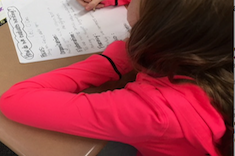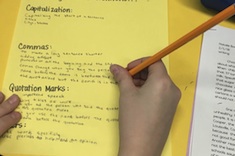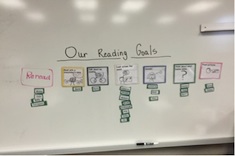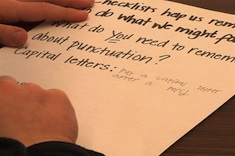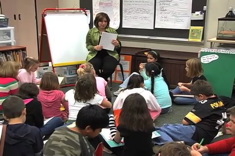Heading into a new school year, or even a new unit, a helpful strategy to remember involves tapping in to what students already know. Pre-assessing at the beginning of a writing unit is a powerful tool. When we know what students are already able to do, we can target and focus our instruction in ways that engage and inspire learners. Although we can use data from previous units or even prior years, I find that pre-assessments are the most useful source of information about students’ current knowledge.
Launching a Unit with Pre-Assessment
In any given writing unit, I like to ask students to write the best piece they can within the genre that will be taught next. I even teach into a process chart for the unit on that first day. For example, if they will be in an information writing unit, I ask them what they know about information writing. Sometimes, a class will be able to list everything and then some about the genre that I’d expect. Other times, I have to give them some of the salient points before I send them on their writing way. In either case, we co-create a chart, making sure it has the following components with greater or fewer details, depending on the grade level. In an information writing unit, the chart should include items along these lines:
- Introduce the topic.
- Develop a plan for your piece.
- Organize the information into sections that help your readers follow what you will be teaching.
- Include text features to elaborate and make your writing more interesting.
- Use transition words to help readers follow what you are writing.
- Use the best grammar and most correct conventions that you know.
- Include a section that lets your readers know your piece is over.
If the unit is a narrative unit, the bulleted points would frame my expectations for a grade-level story. If it’s an opinion unit, the bullets would aim students toward my expectations for that genre. If the unit is a poetry unit, I may ask students to write a couple of poems, showing off some of their favorite poem-writing strategies.
While students are working on this initial piece, I walk around and am anything but quiet. I dole out compliments with specific language that addresses what I hope students will learn over the course of the unit. Some of my compliments may include these:
- “You have clearly let readers know what you will be teaching them.”
- “I love that you have included a how-to section.”
- “You are an expert at transition words. Also and another really help you add information.”
- “I think every single one of your sentences has a capital letter.”
I have had teachers express surprise at these compliments. “Isn’t this an assessment?” one teacher asked. “Don’t we need to sort of standardize it?” Many teachers I work with think they should be quiet during their pre-assessment. They feel like it’s unfair to give any sort of feedback or instruction as students work on their first piece. I don’t agree with that philosophy.
My feeling is that if students can do something on the first day of the unit with only reminders, then they are fairly close to mastery. If a child can go back and fix capitalization errors because he or she heard me compliment another child, that child doesn’t need a 10-minute minilesson or a conference on that skill. If someone can write a hook and an introduction because I’ve read someone else’s out loud, same comment. I might need to remind them in subsequent lessons, but I can teach them more advanced skills to enhance what they’re already showing me they know.
The most important element for pre-assessment centers on remembering the purpose. Fundamentally, pre-assessment gives information to guide instruction. Therefore, what information are we able to glean by asking students to complete a task without much instruction? In addition to doling out compliments, I am taking notes during the students’ work period. Frequently, I set up a chart and engage in some serious student watching. I will have the work itself to give me information about the writing per se, so I like to focus my observations more on behaviors and writing habits. The chart might look something like this:
| Classroom: Date: Unit: | |
|
What I’ve noticed Behavior/skill |
Students |
|
Difficulty thinking of a topic |
|
|
Stamina (number of minutes on task, off-task behaviors, # of words or lines completed in a given period of time) |
|
|
Planning behaviors |
|
|
Methods of revision (erasing, cross-offs, carets, asterisks) |
|
|
Ability to incorporate a compliment or a share of classmates’ work |
|
|
|
|
|
|
|
I always like extra lines so I can add behaviors that I didn’t think of earlier. Watching students is a great way to come up with other things they do well or need to master.
Another response I’ve heard from teachers is whether it’s worth the time. Honestly, pre-assessing could be one of the biggest time-savers I know of. Not only does pre-assessment offer valuable information about where to prioritize and focus, but it also helps us realize what students already may know and be able to do. When it’s done well and looked at carefully, I have seen many teachers realize that there were many lessons they didn’t need to teach as a whole-class minilesson. The day it takes to introduce the process is a worthwhile investment that pays dividends throughout the unit.



